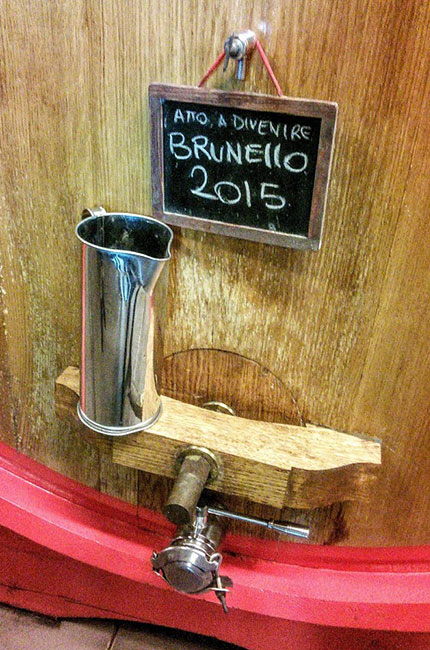
Jefford on Monday: Brunello’s breakthrough
Andrew Jefford gauges the challenges facing Montalcino…
Jefford on Monday: Brunello’s breakthrough
‘We were living in misery; now we are lords.’ Those were almost the first words spoken to me during a recent visit to Brunello di Montalcino. Not by a winegrower (their phrasing is more circumspect, both on misery and lordliness), but by a Montalcinese whose family has long lived in this small town of just under 6,000 people: Alessandro Pierangioli. The Pierangiolis were sharecroppers and cellar workers for Biondi-Santi for many years; now, though, Alessandro and his wife have a wine shop and a gelateria, and he drives tourists to wineries during the summer season. He’s seen a lifetime of rising prosperity.
The change came during the last quarter of the twentieth century. ‘Historically, everyone came through Montalcino on their way to see the Pope,’ said Sebastian Nasello of Podere Le Ripi, alluding to the former road from Florence and Siena to Rome. ‘But we got poorer with the car. After World War Two, no one invested here.’ Italy’s main north-south motorway, the A1, was built between 1956 and 1964, and circumnavigated the once-fortified hilltop town of Montalcino. Abandoned by passing trade, the town fell back on its agricultural resources: not just wine, but forestry, olive oil, honey and the growing of the ancient strain of wheat called spelt.
The town’s DOC may have been awarded as long ago as 1966, but international acclaim came much later; my 1973 edition of The Penguin Book of Wines, written by Allan Sichel, fails even to mention Montalcino, though Chianti and Vino Nobile di Montepulciano are name-checked. For all that, the groundwork had been laid in the nineteenth century by the Biondi-Santi and Colombini (Fattoria dei Barbi) families: the vital thread of ambition and refinement which positioned Brunello as one of Italy’s greatest red wines, if one little-known abroad. The modern impetus for Brunello di Montalcino, by contrast, came with the noisy, earth-moving arrival of the American Mariani brothers at Banfi in 1977 – and with the olive-killing frosts of 1985, which saw many former olive groves replanted with vines.
I mention this history simply to point out that the phenomenon of Brunello di Montalcino as an internationally traded, collectable fine wine to rival the other great Bs – Bordeaux, Burgundy, Barolo and Barbaresco – is a recent phenomenon. (The arrival of Bolgheri in the club is more recent still.) Much evolution lies ahead. I will explore these themes in a feature-length article for next May’s edition of Decanter magazine, but let me just outline some of the challenges the now-fortunate Brunello needs to meet as it decides what sort of a fine wine it wishes to be.
Brunello di Montalcino 2010 panel tasting – exclusive to Decanter Premium subscribers
One challenge is that of explaining and presenting itself. In theory, Brunello should be easy to understand, at least by comparison with the complexities of Chianti: it is a single, unitary area, roughly square in shape, lying to the south of Siena and rather closer to the sea than does Chianti. That apparent simplicity, though, hides some intriguing complications.
Montalcino is a single, large commune of 31,200 ha, yet vines occupy no more than 12 per cent of that area: a total of 3,500 ha. This is the growing zone for four different wines: the DOCG of Brunello di Montalcino (including its Riserva incarnation), the DOC of Rosso di Montalcino, the DOC of Sant’Antimo and the little-used sweet-white DOC of Moscadello (based on a local strain of the Moscato grape). In addition to that, vines grown inside the commune of Montalcino are also eligible for IGT Toscana – and, should producers wish, they can also make both Chianti and Chianti Colli Senesi in Montalcino, too, though few do this.

A cask destined to eventually become Brunello when its ageing period is complete. Credit: Andrew Jefford.
There are only 60 ha of Moscadello planted in Montalcino, and just 480 ha of vineyards are used for Sant’Antimo – a libertarian DOC for both red and white international varieties and Vin Santo. The DOCG of Brunello di Montalcino is currently approved for 2,100 ha. Rosso di Montalcino is available for wines from the same vineyards cropped at different yields and made to different ageing protocols. Note, though, that there are also a further 510 ha of ‘secondary’ vineyards in the commune of Montalcino that are only classified for Rosso and not for Brunello itself. The number of hectares used for Rosso di Montalcino varies every year depending on the quality of the overall red-wine harvest – though in general the production volume of Rosso is around half that of Brunello (4.5 million bottles compared to 9 million). Some 350 ha are used for IGT Toscana and the Chianti denominazioni (mainly Toscana).
Another challenge for Brunello is to improve its mapping. The best available map at present is that in The World Atlas of Wine, but its scale is relatively small and many of today’s leading estates are missing from it; the Consorzio’s own map shows the relative position of the region’s estates, but the topography is almost greyed out and hard to see among the mass of domain identifications. There are maps in Kerin O’Keefe’s useful and thoroughly researched Brunello di Montalcino (a book I thoroughly recommend), but these are rudimentary, without contour lines, and in my edition the maps for North Montalcino and South Montalcino are in the wrong place. I fervently hope the cartographer Alessandro Masnaghetti can tackle Montalcino at some point: that would be of great benefit both to wine drinkers and to the region itself.
Since this is the certainty: wine enthusiasts are going to want to know much more about Brunello di Montalcino in future years. There is no plan at the official level to develop a system of sub-regional zones or crus – but this will inevitably become the major story of Brunello over the next two decades, returned to time and time again by those who visit the region, and constantly alluded to by those who write about the region. Even though there is no official project, I note that the Consorzio did (back in 2012) commission soil studies which divide the region into around four sub-groupings: a North-Western section based on galestro (friable limey clay); a North-Eastern section based on heavier clay; a South-Eastern section based on limestone and sandstone, and a South-Western section based on sandy marine deposits.
Many producers are already labelling their wines with the names of toponimi (referring to place names in the land register) and many more will follow. Even Biondi-Santi is proposing to reorganise its product range; this will not, as at present, reflect vine age, but reflect vineyard of origin. Bordeaux apart, in every other one of the ‘great B’ regions, the future looks parcellaire, as it has long been in Burgundy. Sub-regionality will be a point of interest even for those producers who intend to continue blending from vineyard sources in different zones of Montalcino, as Giancarlo Pacenti of Siro Pacenti confirmed. ‘I’m absolutely not against zoning. Maybe we can make more complex wines by blending complementary zones, but every sub-region has its different characteristics and those are definitely worth understanding.’
Another area where there may be some movement in the future concerns the different age categories of Montalcino’s wines. Everyone is happy with the performance of Rosso di Montalcino; indeed it is hard not to see its adoption (DOC from 1984) as a stroke of genius for any region which, like this one, makes a commitment to its consumers to sell them wine in a semi-mature state (such is the effect of the existing ageing requirements for Brunello di Montalcino).
Rosso serves at least four purposes. It’s a way of turning less propitiously sited vineyards, or young-vine plantings, to good effect; it serves as a ‘second wine’ to up the quality of Brunello itself, particularly after difficult harvests; it’s a useful entry point for debutant or modestly resourced consumers to taste something of the excitement of pure Sangiovese grown in this distinctive Tuscan zone; and it helps producers keep afloat financially by providing them with income while they finance the stocks which the Brunello rules require them to hold (at least five harvests doze in the cellar at any one time).
The Riserva category is a different matter. At present, only seven per cent of Brunello is held back to be marketed as Riserva, whose rules stipulate an extra year’s ageing; more than half the producers don’t bother with this category at all. There is a culture of legendary, time-defying Riserva wines for a few producers (Biondi-Santi has produced just 38 Riserva wines since 1888), but for many, the pinnacle of their work is considered to be Brunello itself. Brunello is the ‘grand vin’, and the Riserva is a kind of footnote or afterthought. Indeed it’s not unusual to hear both critics and consumers of Brunello express a preference for the year-five Brunello rather than the year-six-or-more Riserva wines, which are often alleged to be a little dry, hard and intellectual, lacking wealth and architecture of fruit.
So what’s to be done? It may seem counter-intuitive, but Stefano Cinelli Colombini of Fattoria dei Barbi, Vice President of the Consorzio, thinks that Riserva should become an even older wine than it at present is – one that was sold from around eight years, for example. In other words, a selected, cellar-aged wine to act as a counterpart to the wood-aged Brunello, and to act as a ‘super-premium’ alternative to Brunello, particularly for the Asian market. ‘I have often heard Chinese consumers say “Your wines are not expensive enough to be luxury wines”. We have an image problem for those consumers.’ Another possibility, perhaps, might be a tasting-based tier of wines in place of Riserva. It can’t have passed unnoticed in Montalcino that Chianti’s Gran Selezione seems to be a hit with consumers.
The one change which no one is proposing is the inclusion of any grape variety other than Sangiovese for Rosso di Montalcino, for Brunello di Montalcino or for the Riserva category. The trauma of the Brunellogate scandal of 2008 cauterised the region against the drift away from Sangiovese, and a huge plus point for Brunello is that this has now become the global reference for Sangiovese (even Chianti Classico can contain up to 20 per cent of ‘other’ varieties, including Cabernet and Merlot). The market mood regarding varietal intruders in Italy’s classic zones may have changed, in any case. Such varieties are allowed in Sant’Antimo, but this DOC struggles.
Look out for next May’s edition of Decanter for more on Montalcino, including tasting notes on a range of outstanding recent wines, and a reflection on the kind of uniqueness of scent and flavour that Brunello offers drinkers.
Read more Andrew Jefford columns here
You may also like:

